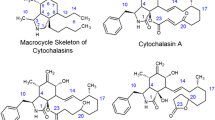Abstract
Background
Although cisplatin is a frequently used cancer chemotherapeutic drug, its effectiveness is hindered by the development of resistance in cancer cells. In order to understand the reason(s) for this resistance, the mechanism of uptake of cisplatin into cells must be characterized. While several previous studies showed structural differences between cisplatin-sensitive and resistant cells, the influence of microfilaments, known to affect transport of molecules into cells, and the influence of certain biophysical characteristics of the plasma membrane needed clarification.
Results
We show that resistant human epidermal carcinoma (KB-CP20) and liver carcinoma (BEL-7404-CP20) cells become relatively more resistant if their already weak microfilaments are degraded by cytochalasin B treatment (.5–2 μM). The sensitive counterparts of these cells with intact microfilaments are not significantly affected by this treatment. We also show that the “fluidity” of the plasma membrane and the membrane potential of the sensitive and resistant cells studied do not appear to influence the uptake of cisplatin into the cells.
Conclusion
Our results suggest that the status of the microfilament system influences the mechanism of uptake of cisplatin into cells.





Similar content being viewed by others
References
Kuwahara D, Tsutsumi K, Kobayashi T, et al (2002) Inhibition of caspase-9 activity in cisplati-resistant head and neck squamous cell carcinoma. Nippon Jibi Inkoka Gakkai Kaiho 105:152–157
Chen ZS, Mutoh M, Sumizawa T, et al (1998) An active efflux system for heavy metals in cisplatin-resistant human KB carcinoma cells. Exp Cell Res 240:312–320
Shen DW, Pastan I, Gottesman MM (1998) Cross-resistance to methotrexate and metals in human cisplatin-resistant cell lines results from a pleiotropic defect in accumulation of these compounds associated with reduced plasma membrane binding proteins. Cancer Res 58:268–275
Shen DW, Goldenberg S, Pastan I, Gottesman MM (2000) Decreased accumulation of [14C]carboplatin in human cisplatin-resistant cells results from reduced energy-dependent uptake. J Cell Physiol 183:108–116
Johnson SW, Swiggard PA, Handel LM, et al (1994) Relationship between platinum-DNA adduct formation and removal and cisplatin cytotoxicity in cisplatin-sensitive and -resistant human ovarian cancer cells. Cancer Res 54:5911–5916
Britz O, Serrano MA, Macias RIR, Marin JJG (2000) Overcoming cisplatin resistance in vitro by a free and liposome-encapsulated bile acid derivative, Bamet-R2. Int J Cancer 88:287–292
Kopf-Maier P, Muhlhausen SK (1992) Changes in cytoskeleton pattern of tumor cells by cisplatin in vitro. Chem Biol Interact 82:295–316
Shen DW, Liang XJ, Gawinowicz MA, Gottesman MM (2004) Identification of cytoskeletal [14C] carboplatin-binding proteins reveals reduced expression and disorganization of actin and filamin in cisplatin-resistant cell lines. Mol Pharmacol 66:789–93
Liang XJ, Mukherjee S, Shen DW, et al (2006) Endocytic recycling compartments altered in cisplatin-resistant cancer cells. Cancer Res 66:2346–53
Liang XJ, Shen DW, Gottesman MM (2004) A pleiotropic defect reducing drug accumulation in cisplatin-resistant cells. J Inorganic Biochem 98:1599–1606
Liang XJ, Yin JJ, Zhou JW, et al (2004) Changes in biophysical parameters of plasma membranes influence cisplatin resistance of sensitive and resistant epidermal carcinoma cells. Exp Cell Res 293:283–291
Plageman PG, Zylka JH, Erbe J, Estensen RD (1975) Membrane effects of cytochalasin B. Competitive inhibition of facilitated diffusion processes in rat hepatoma cells and other cell lines and effect on formation of functional transport sites. J Membr Biol 11:77–90
Soreng KM, Weber DA, Joshi H, et al (1995) A role for microfilaments but not microtubules in processing soluble antigens. Cellular Immunol 166:25–34
Cimini D, Fioravanti D, Tanzarella C, Degrassi F (1998) Simultaneous inhibition of contractile ring and central spindle formation in mammalian cells treated with cytochalasin B. Chromosoma 107:479–85
Kapp T, Muller S, Gust R (2006) Dinuclear alkylamine platinum (II) complexes [1,2-bis(4-fluorophenyl)ethylenediamine]platinum(II): influence of endocytosis and copper and organic cation transport systems on cellular uptake. Chem Med Chem 12:560–564
Choi BH, Park JA, Kim KR, et al (2005) Direct block of cloned hKv1.5 channel by cytochalasins, actin-disrupting agents. Am J Physiol Cell Physiol 289:C425–C436
Akiyama S, Fojo A, Hanover JA, et al (1985) Isolation and genetic characterization of human KB cell lines resistant to multiple drugs. Somatic Cell Mol Genet 11:117–126
Shen DW, Akiyama S, Schoenlein P, et al (1995) Characterization of high-level cisplatin-resistant cell lines established from a human hepatoma cell line and KB adenocarcinoma cells: cross-resistance and protein changes. Br J Cancer 71:676–683
Wieland T (1977) Modification of actins by phallotoxins. Naturwissenschaften 64:303–309
Aszalos A, Yang GC, Gottesman MM (1985) Depolimerization of microtubules increases the motional freedom of molecular probes in cellular plasma membranes. J Cell Biol 100:1357–1363
Aleman C, Annereau JP, Liang XJ, et al (2003) P-glycoprotein, expressed in multidrug resistant cells, is not responsible for alterations in membrane fluidity or membrane potential. Cancer Res 63:3084–3091
Liang XJ, Shen DW, Garfield S, Gottesman MM (2003) Mislocalization of membrane proteins associated with multidrug resistance in cisplatin-resistant cancer cell lines. Cancer Res 63:5909–5916
Shen DW, Goldenberg S, Pastan I, Gottesman MM (2000) Decreased accumulation of [14C] carboplatin in human cisplatin-resistant cells results from reduced energy-dependent uptake. J Cell Physiol 183:108–116
Qualmann B, Kessels MM, Kellt KB (2000) Molecular links between endocytosis and the actin cytoskeleton. J Cell Biol 150:F111–F116
Schafer DA (2002) Coupling actin dynamics and membrane dynamics during endocytosis. Curr Opinion Cell Biol 14:76–81
Andrews PA, Albright KD (1992) Mitochondrial defects in cis-diamminedichloroplatinum(II)-resistant human ovarian carcinoma cells. Cancer Res 52:1895–1901
Acknowledgements
We would like to thank George Leiman for his assistance with the text and figures. This research was funded by the Intramural Research Program of the NIH, Center for Cancer Research, National Cancer Institute.
Author information
Authors and Affiliations
Corresponding author
Rights and permissions
About this article
Cite this article
Liang, XJ., Yin, JJ., Taylor, B. et al. Disruption of microfilaments by cytochalasin B decreases accumulation of cisplatin in human epidermal carcinoma and liver carcinoma cell lines. Cancer Chemother Pharmacol 62, 977–984 (2008). https://doi.org/10.1007/s00280-008-0687-9
Received:
Accepted:
Published:
Issue Date:
DOI: https://doi.org/10.1007/s00280-008-0687-9




